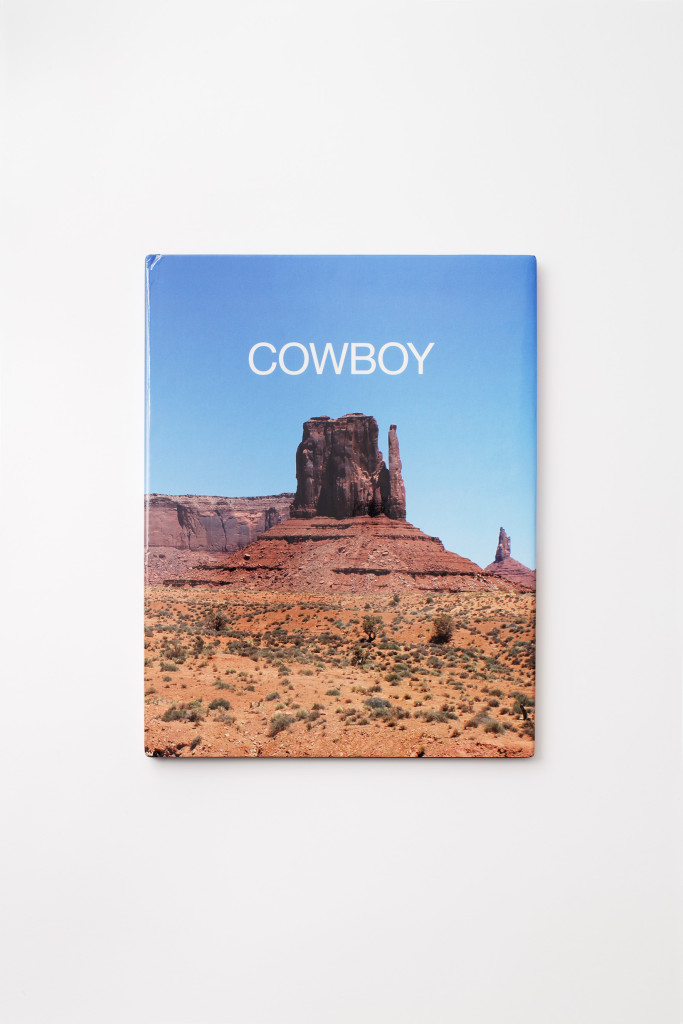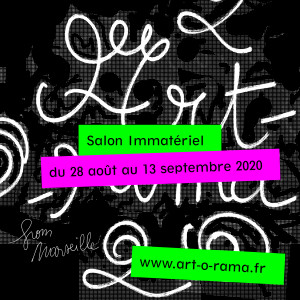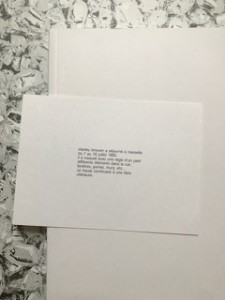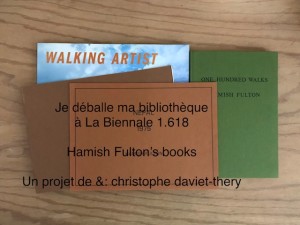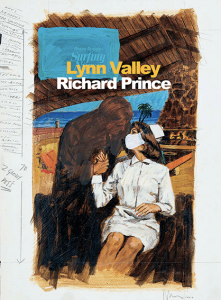Vis-à-Vis 7
Vis-à-vis, nom masculin, personne ou chose située en face d’une autre.
Grande est la tentation de ne réduire la présentation de vis-à-vis qu’à cette seule définition.
En effet, né, d’une réflexion sur la forme de l’exposition et sur la réduction d’une pensée à la seule confrontation de deux oeuvres, la forme même du vis-à-vis est minimale et silencieuse, renforçant ainsi la notion d’espace, voir de vide, qui sépare les deux oeuvres, espace occupé par le visiteur qui devient ainsi le pivot, le trait d’union de la confrontation.
Initiés dans le contexte d’une librairie, ces vis-à-vis s’apparentent par leur contenu à une bibliothèque comme lieu de rencontre, de confrontation et de mise en dialogue de tous les savoirs dont la transversalité s’exprime par la possibilité de faire se rencontrer différents médiums, qu’il s’agisse d’un livre, d’un film, d’un son, voire d’un objet usuel.
Ils sont aussi autant d’étagères imaginaires, sur lesquelles une main invisible vient placer, côte à côte, deux livres. Par quel cheminement passe cette rencontre et pourquoi ? La volonté de les réunir par thèmes, par provocation, par hasard, par négligence, par sentimentalisme ou en rapport avec le contexte d’apparition ? Probablement tout cela à la fois et peut-être avant tout pour voir ce qui se passe.
Vis-à-vis, nom masculin, personne ou chose située en face d’une autre.
Prenant pour contexte les Rencontres d’Arles, ce nouveau vis-à-vis s’intéresse à la fonction assignée à l’image et à son pouvoir en confrontant Proof de François Havegeer, et Sacha Léopold et A Second History de Zhang Dali. À une époque de réalité virtuelle, donc possiblement manipulée, voire orientée, et de théories du complot, la nécessité de la preuve par l’image s’impose avec d’autant plus d’acuité.
1- Havegeer (François), Léopold (Sacha) Proof. Paris, Empire, 2018
Une archive visuelle des destructions d’objets d’art par l’État Islamique.
Depuis 2014 les unités nommées Kata’ib Taswiya mènent pour le compte de l’organisation État Islamique une action de destruction du patrimoine culturel des zones occupées. Suivant une idéologie qui refuse toutes formes d’art ce sont ainsi sculptures, livres et donc histoire qui disparaissent. L’ouvrage Proof se pose comme une archive imprimée, un livre de l’art dans ses dernier instants à travers une sélection de captures d’images issues des vidéos de propagande diffusées sur les médias d’informations numériques.
/
2 – Dali (Zhang) Lynn Valley 7. A second History. Port Colborne, Ontario, Bywater Bros. Editions, 2012
Avec A Second History , Zhang Dali examine la pratique généralisée des manipulations photographiques effectuées par le gouvernement chinois sous le régime de Mao Tse-Toung (1949-1976).
Fonctionnant sur un système de comparaison, ce livre d’artiste présente en regard et de façon chronologique les images originales non modifiées et leur version manipulée aux fins de propagande. On prend la mesure des modifications effectuées par la censure. Dans certaines images, des personnages clés ont été effacés alors que dans d’autres, des personnes ont été ajoutées. Les fonds ont été modifiés tout comme certains slogans sur des bannières.
Par sa pratique, Zhang Dali pose la question de la réalité de la photographie et de son objectivité.
____________________________________________________
Vis-à-Vis 7
Vis-à-vis, masculine noun, person or thing facing another.
It is extremely tempting to reduce the way vis-à-vis is presented just to this definition.
The very form of the vis-à-vis, which in fact stems from a way of thinking about the form of the exhibition and reducing a thought merely to the confrontation of two works, is minimal and silent, thus heightening the notion of space, and even void, which separates the two works—space occupied by the visitor who thus becomes the pivot or hyphen in the confrontation.
These vis-à-vis, begun in the context of a bookshop, are akin through their content to a library as a meeting-place, where there is confrontation and dialogue covering all knowledge, whose transversality is expressed by the possibility of getting different media to meet, be it a book, a film, a sound, or even an ordinary object.
They are also so many imaginary shelves, on which an invisible hand places two books, side by side. By what path does this encounter pass, and why? The desire to put them together by theme, out of provocation, haphazardly, out of negligence, or sentimentality, in relation to the context of appearance? Probably all of the above, and perhaps, above all, in order to see what happens.
Vis-à-vis, masculine noun, person or thing facing another.
In the context of the Temple Arles Books during Les Rencontres d’Arles 2019 , this new participant explores the function assigned to an image and its power, by placing Proof by François Havegger and Sacha Lépold face to face with A Second History by Zhang Dali. In our age of virtual reality, one that is heightened and possibly manipulated or oriented, and when conspiracy theories abound, providing proof via an image becomes more and more necessary.
1- Havegeer (François), Léopold (Sacha) Proof. Paris, Empire, 2018
A visual archive of the Islamic State’s destruction of artifacts.
Proof is a printed visual archive composed of video screenshots from ISIS propaganda films, captured directly from the Internet. It shows how, since 2014, cultural history was physically destroyed by special units “Kata’ib Taswiya”.
Proof is a documentation of the last moments of those sculptures and monuments, during and just.
/
2 – Dali (Zhang) Lynn Valley 7. A second History. Port Colborne, Ontario, Bywater Bros. Editions, 2012
In his book A Second History, Beijing-based artist, Zhang Dali, examines the widespread use of photographic manipulation carried out by the Chinese government during the regime of Mao Tse-tung (1949-76). Using a compare and contrast format this artist book presents a chronological sequence of original, unmodified images together with their doctored doppelgängers which were manipulated in party-run, photo labs in the 50s, 60s and 70s for the Chinese propaganda market.
Altered histories are all around us, embedded in our lives to such an extent that it’s become difficult to imagine what reality really is. In today’s era of 24 hour news coverage and its associated « spin » the idea of getting to the « truth » of something seem almost futile, however with projects like A Second History it is now possible to see a small glimpse of historical media manipulation laid bare.
Scanning the spreads one can see the modifications made by the Chinese censors: In some images key people have been erased, while in others people have been added. Backgrounds have been modified and written slogans on flags have been altered. In other parings the edits appear almost unnoticeable as seen in the spread entitled The Sun Comes to the Kucong People, which features images of women workers harvesting hay in a field. The undoctored image, struck from the original negative, shows a young child peeking out from behind a cluster of busy workers… a detail the censors felt a need to remove. The image of a hapless youngster among robust agrarian workers was obviously at odds with the official party line at the time so the child ended up on the cutting room floor.
Unlike his Chinese forbearers who used photography as a tool for indoctrination, Zhang’s use of the medium is more subjective… the core of his presentation is the manipulation itself, with all its associated political, social and artistic implications.
Follow us on instagram: bookadviser
